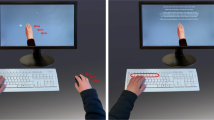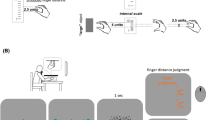Abstract
There is evidence suggesting that viewing hands triggers automatic access to the Body Structural Description, a visual-spatial representation of human body parts configuration. Hands, however, have a special representational status within the brain because of their significance for action and cognition. We tested whether feet, less important in gestural and object-directed action, would similarly show automatic access to the Body Structural Description. Positive evidence of that would be finding a Sidedness effect (Ottoboni et al. J Exp Psychol Hum Percept Perform 31:778–789, 2005), a Simon-like paradigm previously used to study automatic hand recognition. This effect demonstrates that processing hands generates spatial codes corresponding to the side of the body on which the hand would be located within the Body Structural Description map. Feet were shown with toes pointing upwards (Experiment 1), without any connection to the ankle and the leg (Experiment 2) and with toes pointing downwards (Experiment 3). Results revealed a Sidedness effect in both Experiments 1 and 3: spatial compatibility occurred according to the side of the body that each foot would assume within the Body Structural Description. In Experiment 2, as already found in stimuli similarly featured, no effect emerged, due to the lack of the necessary anatomical links connecting the foot to a body. Results suggest that body parts with variable degrees of significance for action and cognition can access automatically the Body Structural Description hence reinforcing the hypothesis of its pure visuo-spatial nature.




Similar content being viewed by others
References
Berlucchi G, Aglioti SM (2010) The body in the brain revisited. Exp Brain Res 200:25–35
Buccino G, Binkofski F, Fink G, Fadiga L, Fogassi L, Gallese V, Seitz RJ, Zilles K, Rizzolatti G, Freund H-J (2001) Action observation activates premotor and parietal areas in a somatotopic manner: an fMRI study. Eur J Neurosci 13:400–404
Buxbaum LJ, Coslett HB (2001) Specialized structural description for human body-parts: evidence from autotopagnosia. Cogn Neuropsychol 18:289–306
Carruthers G (2008) Is the body schema sufficient for the sense of embodiment? An alternative to de Vignemont’s model. Philos Psychol 22:123–142
Corradi-Dell’Acqua C, Rumiati RI (2007) What the brain knows about the body: evidence for dissociable representations. In: Santoianni F, Sabatano C (eds) Brain development in learning environments embodied and perceptual advancements. Cambridge Scholars Publishing, Cambridge, pp 50–64
Coslett HB, Medina J, Kliot D, Burkey AR (2010) Mental motor imagery indexes pain: the hand laterality task. Eur J Pain 14:1007–1013
de Lange FP, Helmich RC, Toni I (2006) Posture influences motor imagery: an fMRI study. Neuroimage 33:609–617
de Vignemont F (2010) The body schema and the body image—Pros and cons. Neuropsychologia 48:669–680
Decety J, Michel F (1989) Comparative analysis of actual and mental movement times in two graphic tasks. Brain Cogn 11(1):87–97
Dijkerman HC, de Haan EHF (2007) Somatosensory processing subserving perception and action: dissociations, interactions, and integration. Behav Brain Sci 30:224–230
Downing P, Jiang Y, Shuman M, Kanwisher N (2001) A cortical area selective for visual processing of the human body. Science 293:2470–2473
Fink GR, Frackowiak RS, Pietrzyk U, Passingham RE (1997) Multiple nonprimary motor areas in the human cortex. J Neurophysiol 77:2164–2174
Fiorio M, Tinazzi M, Ionta S, Fiaschi A, Moretto G, Edwards MJ, Bhatia KP, Aglioti SM (2007) Mental rotation of body parts and non-corporeal objects in patients with idiopathic cervical dystonia. Neuropsychologia 45:2346–2354
Foerster O (1936) Motorische Felder und Bahnen. Springer, Berlin
Funk M, Brugger P (2008) Mental rotation of congenitally absent hands. J Int Neuropsychol Soc 14:81–89
Funk M, Brugger P, Wilkening F (2005) Motor processes in children's imagery: the case of mental rotation of hands. Dev Sci 8:402–408
Gardner MR, Potts R (2010) Hand dominance influences the processing of observed bodies. Brain Cogn 73:35–40
Gentilucci M, Benuzzi F, Bertolani L, Daprati E, Gangitano M (2000) Recognising a hand by grasp. Cogn Brain Res 9:125–135
He SQ, Dum RP, Strick PL (1993) Topographic organization of corticospinal projections from the frontal lobe: motor areas on the lateral surface of the hemisphere. J Neurosci 13:952–980
Ionta S, Fourkas AD, Fiorio M, Aglioti SM (2007) The influence of hands posture on mental rotation of hands and feet. Exp Brain Res 183:1–7
Ionta S, Blanke O (2009) Differential influence of hands posture on mental rotation of hands and feet in left and right handers. Exp Brain Res 195:207–217
Linkenauger SA, Witt JK, Stefanucci JK, Bakdash JZ, Proffitt DR (2009) The effects of handedness and reachability on perceived distance. J Exp Psychol Hum Percept Perform 35:1649–1660
Luppino G, Matelli M, Camarda R, Gallese V, Rizzolatti G (1991) Multiple representations of body movements in mesial area 6 and the adjacent cingulate cortex: an intracortical microstimulation study in the macaque monkey. J Comp Neurol 311:463–482
Mitz AR, Wise SP (1987) The somatotopic organization of the supplementary motor area: intracortical microstimulation mapping. J Neurosci 7:1010–1021
Nico D, Daprati E, Rigal F, Parsons L, Sirigu A (2004) Left and right hand recognition in upper limb amputees. Brain 127:120–132
Oldfield RC (1971) The assessment and analysis of handedness: the Edinburgh inventory. Neuropsychologia 9:97–113
Orlov T, Makin TR, Zohary E (2010) Topographic representation of the human body in the occipitotemporal cortex. Neuron 68:586–600
Ottoboni G, Tessari A, Cubelli R, Umiltà CA (2005) Is handedness recognition automatic? A study using a simon-like paradigm. J Exp Psychol Hum Percept Perform 31:778–789
Paillard J (1999) Body schema and body image a double dissociation in deafferented patient. In: Gantchev GN, Mori S, Massion J (eds) Motor control today and tomorrow. Academic Publishing House “Prof M Drinov”, Bulgaria, Sofia, pp 197–214
Parsons LM (1987a) Imagined spatial transformation of one's body. J Exp Psychol Gen 116:172–191
Parsons LM (1987b) Imagined spatial transformation of one’s hands and feet. Cogn Psychol 19:178–241
Parsons LM (1994) Temporal and kinematic properties of motor behavior reflected in mentally simulated action. J Exp Psychol Hum Percept Perform 20:709–730
Parsons LM, Fox PT (1998) The neural basis of implicit movements used in recognising hand shape. Cog Neuropsychol 15:583–615
Penfield W, Rasmussen T (1952) The cerebral cortex of man. Macmillan, NY
Porro CA, Francescato MP, Cettolo V, Diamond ME, Baraldi P, Zuiani C, Bazzocchi M, di Prampero PE (1996) Primary motor and sensory cortex activation during motor performance and motor imagery: a functional magnetic resonance imaging study. J Neurosci 16:7688–7698
Reed CL, Stone VE, Bozovam S, Tanaka J (2003) The body-inversion effect. Psychol Sci 14:302–308
Rizzolatti G, Riggio L, Dascola I, Umiltà C (1987) Reorienting attention across the horizontal and vertical meridians: evidence in favor of a premotor theory of attention. Neuropsychologia 25:31–40
Rizzolatti G, Riggio L, Sheliga BM (1994) Space and selective attention. In: Umilta’ C, Moscovitch M (eds) Attention and performance XV. MIT Press, Cambridge, pp 231–265
Rubichi S, Nicoletti R (2006) The Simon effect and handedness: evidence for a dominant-hand attentional bias in spatial coding. Percept Psychophys 68:1059–1069
Schwoebel J, Coslett HB (2005) Evidence for multiple, distinct representations of the human body. J Cogn Neurosci 17:543–553
Schwoebel J, Friedman R, Duda N, Coslett HB (2001) Pain and the body schema: evidence for peripheral effects on mental representations of movement. Brain 124:2098–2104
Simon JR (1969) Reaction towards the source of stimulation. J Exp Psychol 81:174–176
Sirigu A, Duhamel JR (2001) Motor and visual imagery as two complementary but neurally dissociable mental processes. J Cogn Neurosci 13:910–919
Sirigu A, Grafman J, Bressler K, Sunderland T (1991) Multiple representations contribute to body knowledge procession: evidence from a case of autotopoagnosia. Brain 114:629–642
Tessari A, Ottoboni G, Symes E, Cubelli R (2010) Hand processing depends on the implicit access to a spatially and bio-mechanically organized structural description of the body. Neuropsychologia 48:681–688
Umiltà C, Riggio L, Dascola I, Rizzolatti G (1991) Differential effects of central and peripheral cues on the reorienting of spatial attention. Eur J Cogn Psychol 3:247–267
Acknowledgments
This study was partially supported by a grant from the Fondazione Cassa di Risparmio di Bologna (n.2005/2445) which AT is involved in and by the European Community, project ROSSI (Emergence of communication in RObots through Sensorimotor and Social Interaction, n. 216125) which AT, GO, GB and RN are involved in.
Author information
Authors and Affiliations
Corresponding author
Rights and permissions
About this article
Cite this article
Tessari, A., Ottoboni, G., Baroni, G. et al. Is access to the body structural description sensitive to a body part’s significance for action and cognition? A study of the sidedness effect using feet. Exp Brain Res 218, 515–525 (2012). https://doi.org/10.1007/s00221-012-3045-4
Received:
Accepted:
Published:
Issue Date:
DOI: https://doi.org/10.1007/s00221-012-3045-4




